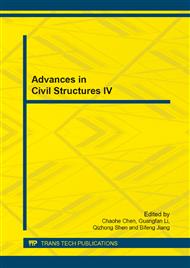p.532
p.536
p.540
p.546
p.550
p.555
p.559
p.568
p.572
Experimental and Theoretical Studies On High-Rise Building Structure With New Special-Shaped Shear Walls
Abstract:
On the basis of concept design that involves both structural and architectural performance, this paper puts forward a new reinforced concrete high-rise building structure with a new special-shaped shear walls, presents an experimental study of the seismic performance of the new special-shaped shear walls under low reversed cyclic loading using MTS electro hydraulic servo system. Compared with experimental results, a finite element analysis on this special-shaped shear wall structure, which considers the nonlinearity of concrete structure, is found suitable. It shows that the experimental results fairly confirms to the calculated values, which indicates that this new structure has advantages as good architectural function, big effective space, high overall lateral stiffness, fine ductility, advanced seismic behavior, etc.. That is, the close agreement between the theoretical and experimental results indicates the proposed shear wall structure has wide applications.
Info:
Periodical:
Pages:
550-554
Citation:
Online since:
July 2014
Authors:
Price:
Сopyright:
© 2014 Trans Tech Publications Ltd. All Rights Reserved
Share:
Citation:


